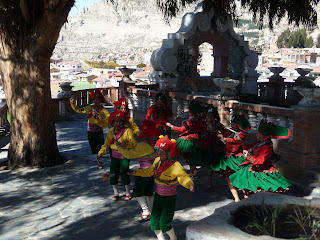We took a night bus from Cochabamba and early the next morning, we arrived in La Paz, the de facto capital of Bolivia. Once we arrived at our hostel, we were surprised to see our hiking buddy Dan there. Dan's friend Jaime was visiting him, and we ended up spending the morning together. We had an excellent pancake breakfast at the hostel, and then wandered around the witches' market. Apparently, it is impossible to construct a building without first getting some supplies from here. For example, a llama fetus bought from the market would be put into the foundation of the building as an offering to Pachamama, and no builder would work for you without first seeing this ceremony.
After walking for about an hour, Dan and Jaime decided to go to a cafe where they could catch up on some work (both were working during their travels), and Radek and I continued to a couple of viewpoints. Going uphill at such an altitude - at approx. 3650 m - was quite demanding, but well worth it. The views were absolutely beautiful. We also saw a group of people being filmed while dancing some traditional dances.
While walking around, we noticed some people dressed up as zebras, teaching drivers how to behave at pedestrian crossings. Apparently, they have been at it for years already, but their efforts have been quite fruitless: pedestrians never have the right of way in La Paz.
During the following week, we went on several trips: we saw the Tiwanaku ruins, hiked near the magnificent Illimani mountain, and Radek raced down the Death Road. We then wanted to go on some more hikes near La Paz, but the weather turned for the worse, so we decided to go to the jungle town of Rurrenabaque instead. Though it was a bit cold there as well for some days, we had a nice time in the pampas and jungle near Rurre, and returned to La Paz at the end of July.
We love to go on free walking tours, or to be more precise, ones that are based on tips, because the guides are usually very nice and motivated. During our trip to Tiwanaku, Christy recommended the Red Cap Walking tour in La Paz, and we were really glad that she did. The tour was an absolute delight! Among other things, our guides recommended that we try Pollos Copacabana, a La Paz-based fast food chain that was indeed very good. It is and has been so popular that it probably contributed to McDonald's going bankrupt in Bolivia (one of the very few countries where that has ever happened). On the tour, we met a nice Danish couple, and decided to have lunch together. Afterwards, we enjoyed some excellent mixed juices at the Mercado Lanza.
The next day, we left for a hike on the Choro trail, and returned three days later. During our resting day, we went to four small museums on the old and beautiful Calle Jaén. The Museum of Folklore had about a dozen miniature scenes of different ages in Bolivia; the Litoral Museum is about the Pacific War, lost to Chile in the end of the 19th century; Casa Murillo was the home of one of Bolivia's most famous freedom fighters - Don Pedro Domingo Murillo. Perhaps the most interesting of the museums was the Museum of Precious Metals, or the Museum of Gold, which displays a myriad of gold and silver workings from the Tiwanaku and Inca cultures.
Soon afterwards, we departed for another hike in the Cordillera Real, this time in the Condoriri area. Upon our return, we visited the San Fransisco Basilica. This church was built in the former indiginous section of La Paz, with the Spanish district on the other side of the Choqueyapu River (now paved over). Its facade has some interesting mestizo influences, including carvings of vomiting men. This must have been what the locals viewed the Spanish - it was the Spanish that brought the catholic church and the art of liquor production to the area. The tour of the church and associated convent was really not that great, but we loved the view from the roof of the church.
 |
| I'm never going to drink again! |
 |
| San Fransisco Basilica |
 |
| A view of the Lanza market from the roof of the San Franscisco Basilica |
The day after visiting the San Fransisco church, we headed for Lake Titicaca, the highest navigable lake in the world.
A gallery with more photos of La Paz can be seen here.
A gallery with more photos of La Paz can be seen here.






No comments:
Post a Comment